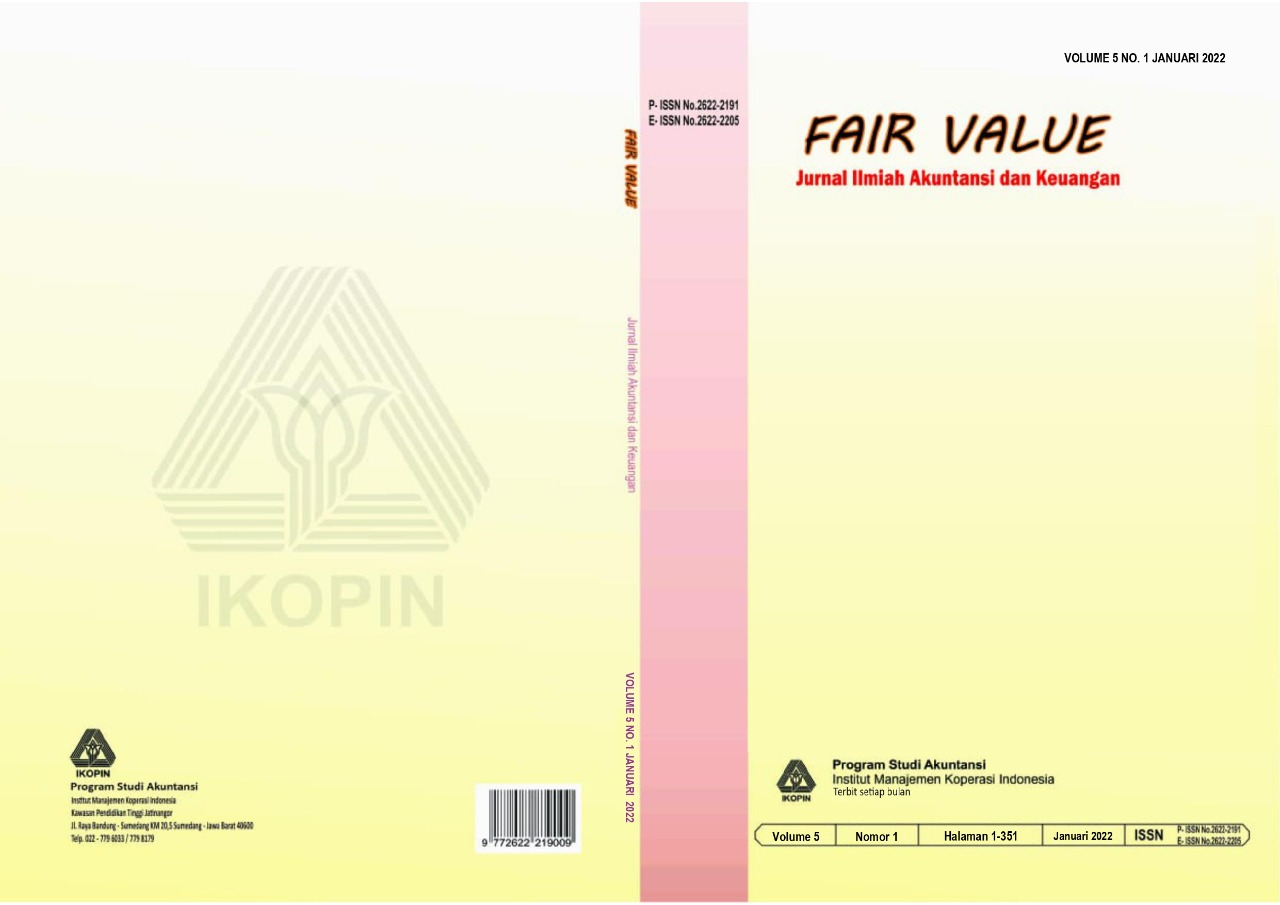Pengaruh intensitas modal, intensitas persediaan, pertumbuhan penjualan dan profitabilitas terhadap agresivitas pajak
Main Article Content
Abstract
Along with the development of the global economy, demanding tough competition in business, all companies are competing to do everything they can to face the competition. Companies that are not able to compete will slowly begin to be eliminated from the business world because they are unable to maintain their company's performance. As a profit-oriented company, of course the company will try to maximize profits in various ways. One of the company's strategies to streamline profits is to carry out tax aggressiveness, namely a strategy to reduce the tax burden so that the company obtain more optimal profits. This study aims to obtain empirical evidence about the effect of capital intensity, inventory intensity, sales growth, and profitability on tax aggressiveness The methodology that the researcher uses is quantitative data, namely the financial
statements of health sector companies listed on the Indonesia Stock Exchange (IDX) to test the hypothesis about the strength of the determinant variable (Independent Variable on tax aggressiveness in this study, regression analysis was used . The results of the stud conclude that capital intensity has no effect on tax aggressiveness, while inventor intensity, sales growth, and profitability have a negative effect on tax aggressiveness
Article Details
References
Amali, L. M., & Sos, S. (2022). Manajemen keuangan. Tahta Media Group.
Anjar, M. (2017). Strategi marketing travel umrah lintas darfiq dalam mempertahankan eksistensi dan
menghadapi persaingan. U-Negeri Sunan Ampel, 85–94.
Ann, S. (2019). The influence of liquidity,profitability,intensity inventory,related party debt,and
company size to aggressive tax rate. Archives of Business Research, 7(3).
Barbera, A., Merello, P., & Molina, R. (2020). Determinants of corporate effective tax rates: evidence
from the euro area. Academia Revista Latinoamericana de Administracion, 33(3–4), 427–444.
Darmadi, I. N. H. (2013). Analisis faktor yang mempengaruhi pajak dengan indikator tarif pajak efektif.
In E-jurnal Akuntansi Universitas Diponegoro (Vol. 26).
Dharma, N. B. S., & Noviari, N. (2017). Pengaruh corporate social responsibility dan capital intensity
terhadap tax avoidance. E-Jurnal Akuntansi, 18(1), 529–556.
Dwiyanti, I. A. I., & Jati, I. K. (2019). Pengaruh profitabilitas, capital intensity, dan inventory intensity
pada penghindaran pajak. E-Jurnal Akuntansi, 27, 2293.
Gian, G. A. P. (2022). Property dan real estate pengaruh financial distress dan intensitas aset tetap
terhadap tax avoidance, peran good corporate governance sebagai pemoderasi. JRB-Jurnal Riset
Bisnis, 5(2), 190–207.
Islami, W., Syafitri, Y., & Meyla, D. N. (2021). Pengaruh inventory intensity, pertumbuhan penjualan
dan profitabilitas terhadap agresivitas pajak. Pareso Jurnal, 3(4).
John G. Fulmer, Howard Finch, A. E. F. (2002). A demonstration of the effect of sales growth on cash
flow. Journal of Entrepreneurship Education, 5.
Kusumastuti, N. R., & Meiranto, W. (2012). Analisis faktor-faktor yang berpengaruh terhadap
kecenderungan kecurangan akuntansi dengan perilaku tidak etis sebagai variabel intervening.
Fakultas Ekonomika Dan Bisnis.
Mandalika, A. (2016). Pengaruh struktur aktiva, struktur modal, dan pertumbuhan perusahaan pada
perusahaan publik yang terdaftar di Bursa Efek Indonesia. E-Jurnal Manajemen Universitas Sam
Ratulangi, 16(01), 207–218.
Mariana, C., Subing, H. J. T., & Mulyati, Y. (2021). Does capital intensity and profitability affect tax
aggressiveness? Turkish Journal of Computer and Mathematics Education, 12(8), 1050–1056.
Maulana, I. A. (2020). Faktor-faktor yang mepengaruhi agresivitas pajak pada perusahaan properti dan
real estate. Krisna: Kumpulan Riset Akuntansi, 12(1), 13–20.
Novitasari, S. (2017). Pengaruh manajemen laba, corporate governance, dan intensitas modal terhadap
agresivitas pajak perusahaan. Journal of Accounting, 4(1).
Nuriyani, N., & Zannati, R. (2017). Pengaruh perputaran kas dan perputaran piutang terhadap
profitabilitas perusahaan sub-sektor food and beverages tahun 2012-2016. Jurnal Riset
Manajemen Dan Bisnis (JRMB) Fakultas Ekonomi UNIAT, 2(3), 425–432.
Nusantari, N. I., Nuzula, N. F., & Darono, A. (2015). Pengaruh agresivitas pajak terhadap
pengungkapan corporate social responsibility (CSR) (Studi pada perusahaan yang terdaftar dalam
indeks sri kehati tahun 2011-2013). Jurnal Administrasi Bisnis - Perpajakan (JAB), Vol. 5 No.
Nyoman Budhi Setya Dharma, N. N. (2012). Pengaruh corporate social responsibilitydan capital
intensityterhadap tax avoidance. SSRN Electronic Journal, 18, 529–556.
Prasista, P. M., & Setiawan, E. (2016). Pengaruh profitabilitas dan pengungkapan corporate social
responsibility terhadap agresivitas pajak penghasilan wajib pajak badan. E-Jurnal Akuntansi
Universitas Udayana, 17(3), 668–676.
Putra, I. W. S., & Wirajaya, I. G. A. (2013). Pengaruh tingkat perputaran kas, piutang dan jumlah
nasabah kredit pada profitabilitas LPD di Kecamatan UBUD. E-Jurnal Akuntansi, 3(1), 119–135.
Rahayu, P. (2019). Pengaruh profitabilitas, leverage, sales growth, dan capital intensity terhadap
penghindaran pajak. Ilmu Ekonomi Perbanas, 6(4), 68–79.
Rivandi, M., & Ariska, S. (2019). Pengaruh intensitas modal, dividend payout ratio dan financial
distress terhadap konservatisme akuntansi. Jurnal Benefita, 1(1), 104.
Sari, D. (2013). Pengaruh profitabilitas, pertumbuhan aset, ukuran perusahaan, struktur aktiva dan
likuiditas terhadap struktur modal pada perusahaan manufaktur di bursa efek indonesia tahun 2008
– 2010. Jurnal Ekonomi Dan Bisnis, 189–198.
Savitri, D. A. M., & Rahmawati, I. N. (2017). Pengaruh leverage, intensitas persediaan, intensitas aset
tetap, dan profitabilitas terhadap agresivitas pajak. Jurnal Ilmu Manajemen Dan Akuntansi
Terapan, 8(November), 64–79.
Serdar, D. (2019). Analisis peran dana desa melalui program pembangunan infrastruktur guna
meningkatkan kesejahteraan masyarakat dalam perspektif ekonomi islam. Journal of Accounting,
(1), 1–14.
Siciliya, A. R. (2020). Intensitas persediaan, ukuran perusahaan, dan agresivitas pajak: koneksi politik
sebagai variabel moderasi. Jurnal Literasi Akuntansi, 28–39.
Tandean, V. A., & Nainggolan, P. (2017). Faktor-faktor yang mempengaruhi tax avoidance dengan
kepemilikan institusional sebagai variabel pemoderasi. Jurnal Akuntansi Bisnis, 9(2).
Tandean, V. A., & Winnie. (2016). The effect of good corporate governance on tax avoidance. Asian
Journal of Accounting Research, 1(1), 28–38.
Wahyu Leksono, A., Stanto Albertus, S., & Vhalery, R. (2019). Pengaruh ukuran perusahaan dan
profitabilitas terhadap agresivitas pajak. Journal of Applied Business and Economic, 5(4), 301–
Widagdo, D. O. K., & Chariri, A. (2014). Pengaruh good corporate governance terhadap kinerja
perusahaan. Diponegoro Journal of Accounting, 307–315.
Zemzem, A., & Khaoula, F. (2016). The effects of board of directors ’ characteristics on tax
aggressiveness the effects of board of directors ’ characteristics on tax aggressiveness. Journal of
Finance and Accounting, January 2013, 3–9.

